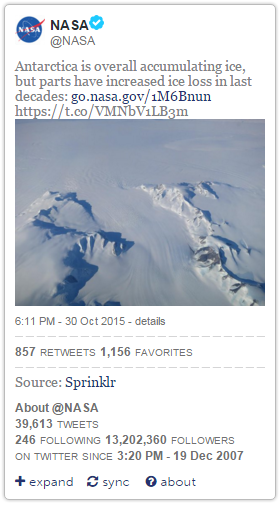 TwitterTrails is a system focused on studying how rumors and memes spread online, but it can also track efforts by spammers to promote spam messages on Twitter. In one such case, which we observed recently, global warming denialists online misrepresented an article posted by NASA to claim that NASA’s article effectively denies the existence of global warming. TwitterTrails discovered their effort and identified 115 of these denialists. Here’s what happened:
TwitterTrails is a system focused on studying how rumors and memes spread online, but it can also track efforts by spammers to promote spam messages on Twitter. In one such case, which we observed recently, global warming denialists online misrepresented an article posted by NASA to claim that NASA’s article effectively denies the existence of global warming. TwitterTrails discovered their effort and identified 115 of these denialists. Here’s what happened:
On October 30th, 2015, NASA posted an article about a study showing that the amount of ice in the Antarctic ice sheet has increased overall. They tweeted about the article, summarizing it with: “Antarctica is overall accumulating ice, but parts have increased ice loss in last decades.”
Several news websites posted articles about the study which were widely shared on Twitter expressing overall skepticism about both the findings and their implications for global warming:
- What Antarctica’s Incredible “Growing” Icepack Really Means by National Geographic
- A controversial NASA study says Antarctica is gaining ice. Here’s why you should be skeptical by the Washington Post
- Is Antarctica Gaining or Losing Ice? Hint: Losing. by Slate
However, the link shared by far the most on Twitter a website called “The Real Strategy” which takes a very different spin on the NASA study:
NASA Debunked Global Warming Hoax in Study
You will not hear this on your mainstream “News” channels… A new study by NASA has proven that the global warming hoax is a myth, once and for all.
A study released by NASA on October 30 says that the amount of ice in the poles has increased steadily over the last several decades. What happened to Al Gore’s claim that the poles would be melted completely by this year? Obama was just filmed claiming that “Global Warming” is proven… How stupid are their audiences really? Has everyone been programmed to just accept what these liars tell them as gospel? This study proves that “Global Warming” is so bogus that the world is actually COOLING!
The story continues on to quote the NASA article at length to support its claim that climate change is a “hoax”. This story received widespread air time on Twitter; nearly 4,000 of the 8,700 tweets we collected in reference to the NASA article included a link to “The Real Strategy,” compared to just a few hundred links to other relevant articles (including NASA’s original).
So, does Twitter audience believe that NASA’s own study disproves global warming? Not quite.
Using TwitterTrails we investigated this question, and found much more to the story. (TwitterTrails’ full record on the story can be explored in full here: http://twittertrails.wellesley.edu/~trails/stories/investigate.php?id=754710850)
Here’s the timeline of activity on Twitter surrounding the NASA study:

Our sample of collected data is shown above with the blue line, and an estimate of total activity surrounding this topic is shown with the grey line.
Activity in the few days immediately following NASA’s post is fairly low. Starting on November 4th, activity picks up in a rather unusual pattern. Zooming on this section of the timeline reveals the following chart:

There is a repeating pattern here, with activity peaking every 10 minutes and 30 minutes past the hour for 30 hours. This is a technique spam-bots (programs created by spammers) have been observed to use in the past. Almost all the tweets posted during these peaks contain a link to The Real Strategy’s article.
Another indication that points to spam activity is the number of unique users posting or retweeting an article compared to the number of times it has been posted or retweeted. Usually, these numbers are equal: in the vast majority of cases, a single user will only post or retweet an article once, with few exceptions. Spammers, on the other hand, try to increase the spread of a certain story or viewpoint by having several accounts each post the article many times in a crude attempt to mimic a large volume of organic activity.
The original NASA post was shared about 500 times by about 500 users. The National Geographic, Washington Post, and Slate articles have similar numbers—a few hundred tweets/retweets by a few hundred users.
In stark contrast, The Real Strategy’s post was shared 3,800 times by a mere 300 users. On average, every user sharing this link posted or retweeted it 13 times. This explains the massive volume of tweets we collected containing that link; tweets linking to The Real Strategy post amount to almost half the relevant data we collected.
Can we tell whether the spammers were successful in spreading their message, especially in comparison to organic activity surrounding the topic?
TwitterTrails attempts to identify spammers using a set of metrics, which include re-posting a link many times, and repeatedly posting tweets with nearly identical text. We identified 115 spammers in this case, out of 4,400 total users in our sample. Yet, the spammers posted 3,300 tweets, or about 40% of the 8,700 total tweets we collected. However, the spread of the spammer’s tweets is only 5, compared to 35 for tweets written by non-spammers. Although they posted in great volume, the denialists’ message had much less impact than the organic discussion of the NASA study, which was more concerned with skepticism of the study and expressing caution about how the study did not refute global warming. (We plan to discuss spam vs organic spread in more depth and compare the spammers in this story to other stories in a future blog post)
So, in this case, global warming denialists made lousy spammers, detected by TwitterTrails.